20+ SAMPLE Vision Statement
-
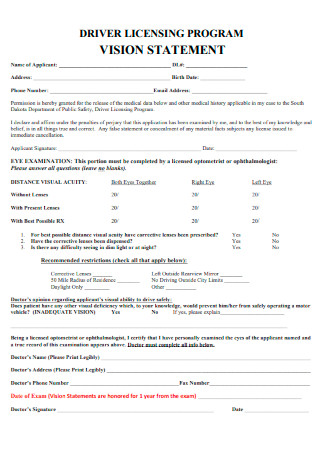
Driver Licensing Program Vision Statement
download now -

Presidents Vision Statement
download now -
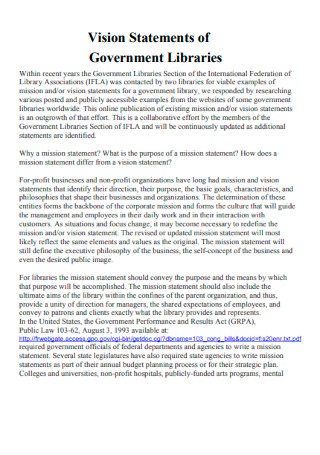
Vision Statements of Government Libraries
download now -
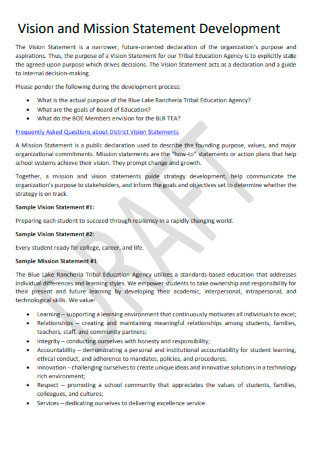
Vision and Mission Statement Development
download now -
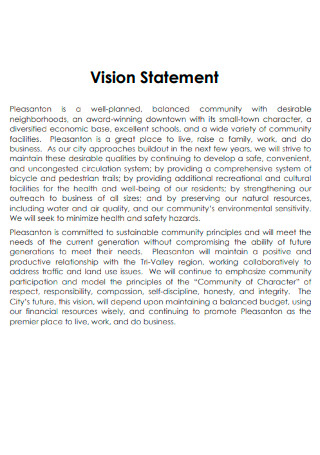
Sample Vision Statement
download now -
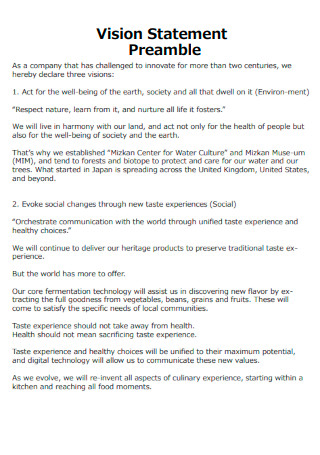
Vision Statement Preamble
download now -

Architectural Vision Statement
download now -
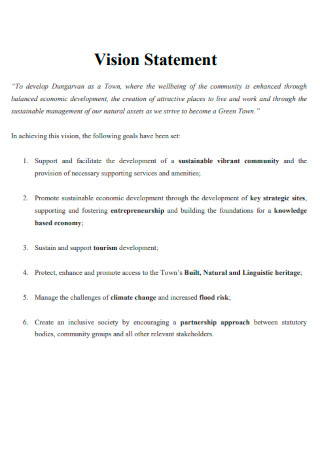
Basic Vision Statement
download now -
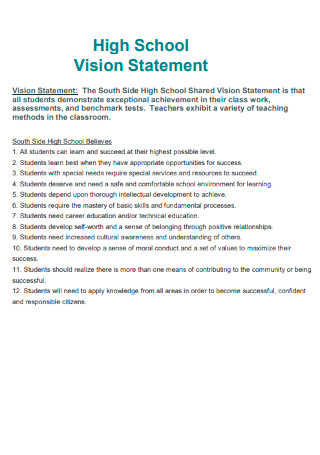
High School Vision Statements
download now -
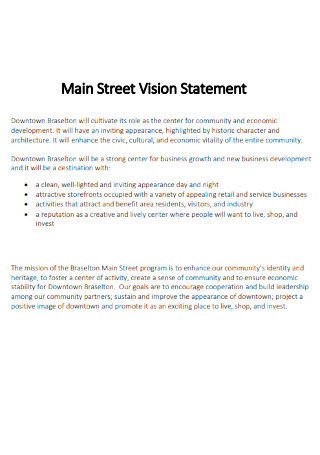
Main Street Vision Statement
download now -

One Page Vision Statement Worksheet
download now -
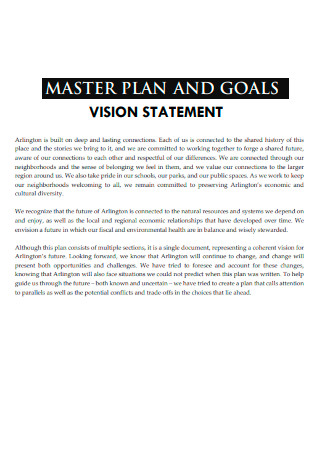
Master Plan and Goals Vision Statement
download now -
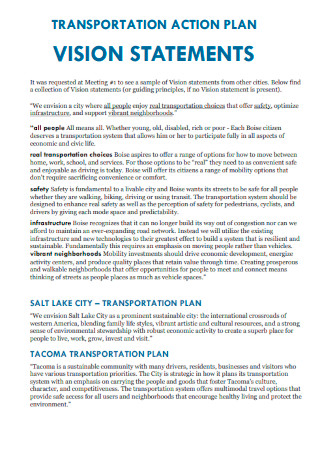
Transportation Action Plan Vision Statement
download now -
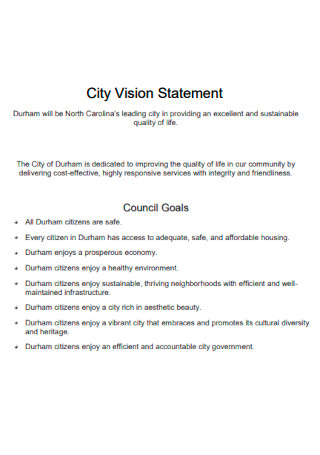
City Vision Statement
download now -
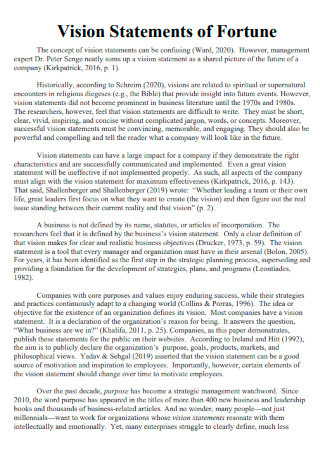
Vision Statements of Fortune
download now -

Vision Statement Worksheet
download now -
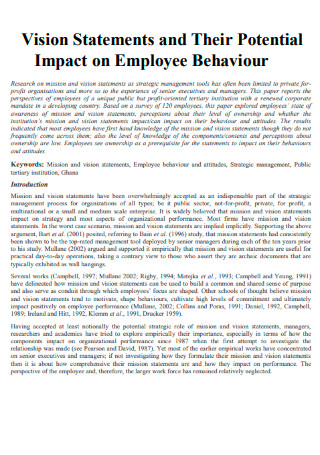
Vision Statements and Their Potential Impact on Employee Behaviour
download now -
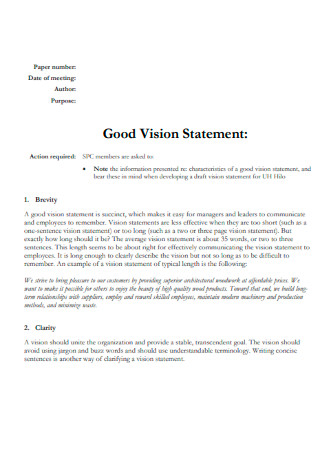
Good Vision Statement
download now -
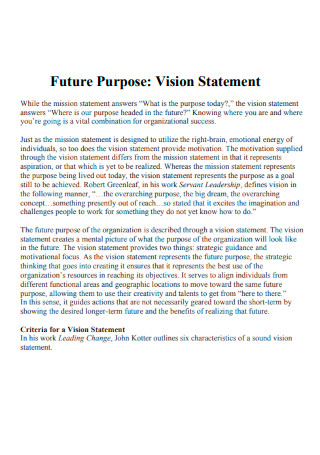
Future Purpose Vision Statement
download now -

Developing a Personal Vision Statement
download now -
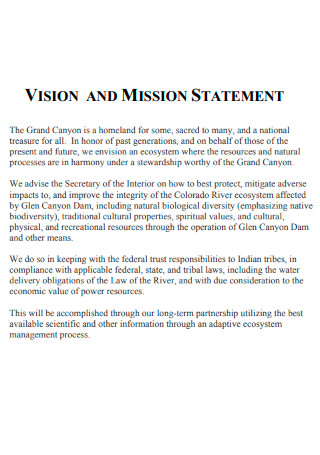
Vision and Mission Statement
download now
FREE Vision Statement s to Download
20+ SAMPLE Vision Statement
a Vision Statement?
Benefits of Vision Statements
Components of a Vision Statement
How To Create a Vision Statement
FAQs
What is an organization’s vision statement?
What characteristics define an effective vision?
How effective are vision statements?
What is a business’s primary objective?
What Is a Vision Statement?
A vision statement is a company record that outlines an organization’s current and future goals. The vision of a business must be consistent with its mission, strategic plan, culture, and fundamental importance. A vision statement is not only utilized in the industry; nonprofit organizations and government agencies also use it to establish strategic goals. Vision statements are not always irreversible. They can be revisited, altered, and updated as needed. However, revisions should be modest, as a vision statement guides a business’s strategic plan and must be thoroughly assessed. An organization’s business vision may evolve as it adapts to its business environment and external variables that may impair its capacity to accomplish its objective. According to research, employees who believe their company’s important goal have an engagement level of 68 percent, 18 points more than the norm.
Benefits of Vision Statements
A vision statement is critical for a business since it serves as a road map for success. It can serve as a guide for employees who run into difficulties. Additionally, vision statements urge personnel to collaborate on common goals. Investors and others interested in the firm can also use the vision statement to better understand the organization’s mission. With a compelling vision statement, a business can attract, engage, and keep talented team members. Diligent, dedicated, and driven employees are more inclined to work for a company with solid principles and objectives. It is necessary to involve team members in their job to keep them engaged. Connecting a vision statement to individual goals might demonstrate to an employee that they are working toward a common goal. If you’re still intrigued, here are a few additional advantages.
Components of a Vision Statement
When writing your organization’s vision statement, be sure to include the following aspects to guarantee a clear, concise message that motivates your employees and other stakeholders:
1. Dedicated to the future
A vision statement must be forward-thinking or indicate your long-term goal. Consider five to ten years from now and the influence you aim to create. You want to set an example for your employees to emulate and a vision that will inspire people to join and support your firm.
2. Exhibits ambition
Your mission statement should include a vision for your organization’s ultimate potential. While a mission statement defines your organization’s customer service, business operations, and a vision statement that outlines your ideal future. A too easily attainable vision is unlikely to inspire others since they will believe your business is not pushing itself to be the best it can be. However, it should be attainable so that people feel their effort contributes meaningfully to that end. If this is not achievable, employees may become demotivated due to the lack of visible progress.
3. Establishes the direction of the organization
Your vision statement should specify the desired outcome for your organization. This feeling of direction enables management to establish objectives that will assist your firm in achieving its objective. As a result, people get a clear grasp of the goal they are working on and become motivated by that purpose.
4. Reflects the values of the organization
Each organization has its own set of ideas that govern its operation. Include those principles to ensure that your vision statement is consistent with your stakeholders and interests. When they believe the vision aligns with their values, they are more motivated to see it through. According to statistics, having a well-defined set of values enables your employees to grasp what you stand for. Additionally, your company values provide people with direction for their job and a sense of protection. As a result, your workers are more likely to make significant judgments that contribute to the company’s vision and goals.
5. Encourages others
Describe a vision for your organization that will excite internal and external stakeholders. It should elicit emotion and connection from your staff to motivate them to contribute to that objective through their daily work. Likewise, you want to establish an emotional relationship with your customers or clients to encourage them to engage with and support your firm. Statistics show that a mission statement gives a good picture of the company’s future and helps it grow. Employees are encouraged to think about how their actions will affect future business success and a good work environment when they read mission statements.
6. Utilizes succinct formatting
Your vision statement should be no more than two sentences long. Because this statement will be read by individuals both inside and outside your organization, you must avoid using jargon specific to your business or industry to ensure that it is understandable by everyone. Compel others to support your vision by using passionate and inspiring language.
7. Demonstrates your uniqueness
When developing a vision statement, it is critical to ensure that it is consistent with your organization’s mission and industry. If stakeholders do not see this alignment, they may get perplexed as to why you chose that vision in the first place. Additionally, you must emphasize the unique value or effect that your firm provides so that stakeholders understand why they should choose you above others.
How To Create a Vision Statement
Developing a solid organizational culture is critical for a business’s long-term success. Additionally, it is essential to keep referencing the vision statement to demonstrate the company’s commitment to that culture. If your company sets you and your team the task of creating a vision statement, it’s beneficial to follow these steps to make a motivational and inspiring option:
1. Determine the organization’s objectives
Long-term growth goals are critical to consider, as are short-term goals for daily achievement. Consider the objectives alongside the approach that will be used to accomplish them. Although the steps do not have to be included in your vision statement, having a roadmap will assist in making the goals more attainable. According to statistics, just 5% of small businesses achieve all of their annual goals. Over 65 percent of small business owners earned more than half of their dreams in 12 months. Only 5% of participants met all of their objectives. The study identified three business sectors where more than a third of firms had developed a process strategy.
2. Describe the values
Each organization has its values. For instance, a health insurance company’s values may be centered on enhancing the relationship between its clients and their healthcare needs. Before you can completely articulate a vision statement, it’s critical to understand the organization’s values, which will ultimately connect with the business’s objectives.
3. Simplify
Your vision statement should be brief, straightforward, and simple to comprehend. It should consist of one or two short sentences. This is where condensing the relevant information into one-to-two sentences might be challenging. You may outline numerous things and then refine and consolidate them to get the final form.
4. Consider the future.
Take into account the industry’s direction to ensure that your message remains relevant in the future. Ascertain that it also matches your company’s long-term objectives. It is okay to be unable to anticipate the future. However, it might be beneficial to consider strategically how this vision statement can remain accurate even as the economy, the organization or business, and its customers through natural changes.
5. Create a timeline
Since a vision statement acts as a road map for an organization’s success, including time frames for each component is beneficial. Consider when you anticipate the business will complete specific milestones and accomplish the objectives outlined in the statement.
FAQs
What is an organization’s vision statement?
A vision statement looks ahead and conjures an image of the organization’s desired state in mind. It is motivating and aspirational and should provide people with opportunities to grow.
What characteristics define an effective vision?
A compelling vision should possess the following elements to serve as a management tool for offering direction to the business. The vision should paint a picture of its future while indicating its market position.
How effective are vision statements?
A vision statement can be a handy tool for keeping a firm on track and uniting its stakeholders—from investors to employees—around a common goal. Additionally, it might have a beneficial effect on a business’s well-being.
What is a business’s primary objective?
Profitability, modern theorists would argue, is a necessary business objective, regardless of its capacity to stimulate growth and development. Profit is, of course, the ultimate goal of any business because it is the primary determinant in maximizing shareholder wealth.
Your vision statement is not fixed in stone, and you can modify it as your business grows. You may outgrow your vision statement—and that is just normal! Consider it a living sentence that will mature and evolve along with your business. However, please take pleasure in the fact that it has been written for the time being. Share it with your team, inform your customers, and use it to guide your business forward confidently.
